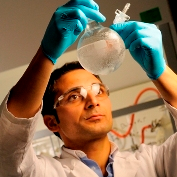Boron-Based (Nano-)Materials: Fundamentals and Applications
A special issue of Crystals (ISSN 2073-4352). This special issue belongs to the section "Inorganic Crystalline Materials".
Deadline for manuscript submissions: closed (31 March 2016) | Viewed by 68297
Special Issue Editors
Interests: boranes; boron- and nitrogen-based materials; chemical hydrogen storage; hydrolytic and thermolytic dehydrogenation; heterogeneous (metal) catalysis
Special Issues, Collections and Topics in MDPI journals
Interests: boron nitride; fibers; nanotubes; nanostructured ceramics; porous ceramics; hierarchical materials; molecular an polymeric precursors of non-oxide ceramics; borazine; borazine-based preceramic polymers; boron-based materials for hydrogen storage
Special Issues, Collections and Topics in MDPI journals
Interests: metal organic frameworks; diffractions techniques; structure determination; structure-properties relations; mechanical and thermal behaviour; boron based materials
Special Issues, Collections and Topics in MDPI journals
Special Issue Information
Dear Colleagues,
As leading scientists in the field, we all agree that among the light elements boron is rather unique. Since the early 19th century, it has fascinated generations of scientists. In the 20th century, it has shown to be versatile, having been widely used in many areas of application including enamels, metallurgy, ceramics, synthetic organic chemistry, fertilizers, fungicides, detergents, soaps, antiseptics, cosmetics, and so forth. In the past decades, boron has been an important element in materials science through the emergence of new and innovative application prospects. Accordingly, the present Special Issue is dedicated to new boron-based (nano-)materials and emphasizes recent advances on fundamentals and application prospects.
In this context, the main focus of the forthcoming “Boron-Based Materials: Fundamentals and Applications” Special Issue is to present a comprehensive overview of the new developments in the field, while focusing on research and review articles about crystalline boron-based (nano-)materials for medicine (e.g., radioisotope and boron neutron capture therapy), health and nutrition, electronics, energy (e.g., hydrogen, fuel cell and nuclear energy), organic and inorganic chemistry, catalysis, ceramics, and any other relevant area of application.
It is our pleasure to invite you to submit a manuscript for this Special Issue. Full papers, communications, and reviews are all welcome.
Prof. Dr. Umit B. Demirci
Prof. Dr. Philippe Miele
Dr. Pascal G. Yot
Guest Editors
Manuscript Submission Information
Manuscripts should be submitted online at www.mdpi.com by registering and logging in to this website. Once you are registered, click here to go to the submission form. Manuscripts can be submitted until the deadline. All submissions that pass pre-check are peer-reviewed. Accepted papers will be published continuously in the journal (as soon as accepted) and will be listed together on the special issue website. Research articles, review articles as well as short communications are invited. For planned papers, a title and short abstract (about 100 words) can be sent to the Editorial Office for announcement on this website.
Submitted manuscripts should not have been published previously, nor be under consideration for publication elsewhere (except conference proceedings papers). All manuscripts are thoroughly refereed through a single-blind peer-review process. A guide for authors and other relevant information for submission of manuscripts is available on the Instructions for Authors page. Crystals is an international peer-reviewed open access monthly journal published by MDPI.
Please visit the Instructions for Authors page before submitting a manuscript. The Article Processing Charge (APC) for publication in this open access journal is 2600 CHF (Swiss Francs). Submitted papers should be well formatted and use good English. Authors may use MDPI's English editing service prior to publication or during author revisions.
Keywords
- Boron science
- Boron-based materials
- Nanomaterials
- Fundamentals
- Applications







